Serving:
Middlesex County and the MetroWest Area of MA
-
AN IMPORTANT MESSAGE FROM BEE BUSTERS INC
To our valued customers:
Contact us directly for triage. Call or text for questions or concerns. Remember that a high percentage of our work is done from outside your home!
All our work is guaranteed until 12/31 of the year we treat. New and existing customers call or text today (978) 302-0985.
Be well and stay safe!
Wasp, Hornet, and Yellowjacket Treatment
Free Phone Estimates | Senior and Military Discounts | Same-Day Service
Free Estimates
Senior and Military Discounts
Same-Day Service
Hours:
After Hours/Emergency Number: 978-302-0985
Quick Pest Management for Stinging Insects
Wasps, yellowjackets, and hornets are unwelcome around just about any property. Unlike bees that provide us with honey and pollination, these stinging insects are regarded as nuisances by almost everyone.
If you have them around your home or business, call Bee Busters Inc for prompt removal and management services. Our team is fully licensed, and we guarantee our work until December 31st of the year in which we do it. Same-day service is available, so
contact us today for a FREE pest identification and FREE estimate.
Yellow Jackets
- Yellowjacket is the common name for predatory social wasps living in colonies with workers, queens, & males (drones). Most are black with yellow stripes, but some include red markings, & some are black with white markings (the Bald-Faced Hornet, which is the black & white marking type, is a sub-type of Yellow Jacket wasp).
- They can be roughly ⅜” to 2” long, depending on the species, with queens and drones about 25% longer.
- There are at least 14 different varieties of Yellow Jackets in New England alone. They can nest “anywhere” -in the ground, bush, house exterior, eves, soffit, tree, in railroad ties, & the list goes on. An average nest can reach 4,000-6,000 by the end of the Summer, with each insect having the potential of multiple stings. A mature nest may typically have 2,000-6,000 cells and 1,000-4,000 + workers.
- They are scavengers eating roadkill, trash, bugs on trees, & even your hamburger at the family picnic. They can damage fruit when they create holes by eating the flesh. These are day-active, beneficial, predatory insects -they eat common insects such as flies & caterpillars.
- They build a paper-like nest containing several layers of cells. Nests are sometimes built in open aerial spots, or within bushes. Some build their nest in a cavity hollowed out below ground. Some workers will act as guards at the entrances to below-ground nests, & they are very protective of their nest. Usually only fertilized queens live over the winter, with the old queen & workers dying out by the first frost.
- Nests are seasonal, gray paper in nature with a condo structure inside covered by a thick papery substance for added protection. They form by scraping old or weathered wood & secreting this substance back at their nest site.
- They will attack when unprovoked; they can quickly become extremely aggressive if their nest is disturbed. Their sting is very painful & may sting repeatedly: they use their retractable needle-like stinger to hunt & kill their prey daily, which means that they never lose it, each time injecting enough venom to kill an insect, unlike a Honeybee-whose stinger pulls out and the honeybee dies.
- After the new fertilized queens have gone into their overwintering sites, the remaining workers begin to seek sweets & garbage near places where humans are active outdoors, or around garbage cans; this is also the time when you might find them near your drink or soda cans during picnics or outside gatherings.
- Just before Winter, the new daughter queens’ mate & find a suitable place to overwinter (attic insulation, wood pile, or anywhere warm they can find). During the Spring, the multiple new queens that were produced last Fall will come out of hibernation, begin feeding, & then start searching for a new nest location site to begin her new colony. Once she finds a place to call home, nest building begins. The sole responsibility of the queen is to reproduce, & the workers begin hive maintenance. There is nothing but nursery comb stored in their nests (no honey, just babies).
- Yellow Jackets Control include keep trash & garbage in sealed containers away from the house; clean up decayed wood, trees, & brush; paint any unfinished wood or stain it; keep bark mulch fresh; avoid areas of standing water in your yard; avoid wearing perfumes or hairsprays; & keep all food & drinks covered when outdoors.
- Never spray insecticide into a hole in your house where you see Yellow Jacket activity; you will drive them further into the framework of the house. Also, never seal up from the outside the Yellow Jacket entrance while they are still active; again, you will drive them into the framework of the home & will find them in rooms of the house.
- In the Fall, they search for food & warmth, making their way inside your home if there is a wall or ceiling nest.
- In the fall ceilings & walls nests become heavy. Hive work is vigorous, & workers continue to clean up after the young. During this cleaning process, they often scrape away wallboard & plaster that make up our walls & ceilings. Some homeowners will begin to see a wet stain on their wall, hear scratching & ticking/clicking sounds in their ceiling. This is often described as rice-crispy sounds. Often, if warning sounds are not addressed homeowners find an entire colony falling through the ceiling into their living room, bedroom, or other rooms of their home.
- Nest removal can be dangerous, & professional help is recommended. The risk of attack is great.
Paper Wasps and Umbrella Wasps
- Have a Yellow-colored antennae compared to a Yellow Jacket’s black antennae.
- Are ⅝” to ¾” long (or between ½” to 1” long) and are more slender than Yellow Jackets.
- Usually brownish with yellow markings, some have red markings (or mostly yellow with small areas of black, depending on the type or color of the wasps).
- They build a grayish-colored, single-layer, paper like comb with cells opening downward (the nests consist of a single layer of exposed cells, with no protective outer layer existing on them).
- Nest is attached by a single long pedicel to a twig, tree branch, or horizontal surface, like an eave, window frame, soffit, or overhang.
- They are beneficial insects, are active in the daytime, feed mainly on other insects, many of which are plant pests, such as caterpillars and garbage, and are beneficial to any gardener.
- A mature colony may number 100-250 workers (sometimes up to 300 workers, if a large enough colony is encountered); workers are quite protective of their nest, and will give a painful sting, often repeated stings, if they or their nest are disturbed, provoked, or mis-handled.
- Control of paper wasps or removal of their nests should be left to a professionally trained and equipped professional (knocking down the nest without proper treatment is worthless, since the wasps will only rebuild it).
- A recently introduced species, has spread throughout most of the Eastern U. S.; some workers of this species may survive the winter in the southern states, and they often will re-use and expand the previous year’s nest, which may get as large as a typical hornet’s nest after several years.
- Often enter homes in fall, seeking a place to hibernate.
- Survive for one year only, and nests are not reused, except as specified above.
- Fertilized queens overwinter and build new nests in the spring.
- All females are potential queens, there are no worker castes in any colony: the one who begins to build becomes the queen, and the other females take on a subservient role of foraging for food and feeding the young.
Bald-Faced Hornets
- Known as the “White-Faced,” “Bald-Faced,” or “White-tailed” Hornet.
- Considered a large wasp: widespread in 46 of the United States.
- Large (⅝ to ¾ inches long) & are black with white markings.
- Nests are found in trees or shrubs, & sometimes on buildings. Often 12 inches or more in diameter, they become exceptionally large by the end of the summer. Removal of their nests should be left to a professionally trained & equipped professional.
- Insects are considered extremely aggressive and will attack without being provoked.
- Insects are considered “social wasps,” & are related to Yellow Jackets & Paper Wasps (“Wasp” family” of insects).
- Live in colonies (nests are colonies) like Honeybees & Ants.
- Nest construction is paper-like material made from chewed wood fibers mixed with saliva (most “wasp” nests are made from the same process & materials). Has several tiers of comb & a thick, multi-layered outer shell. A single opening at the bottom allows the hornets to fly in & out.
- Life cycle consists of 4 stages-Egg, Larva, Pupa, & Adult.
- Are beneficial predators that feed on other insects, particularly flies.
- Colony lives for 1 season (1 year): each nest is built from scratch each year, & the previous nest cannot be reused.
- At first, colony growth is slow at the start of season, but increases rapidly by the end of the Summer when successive broods of workers emerge. Peak worker populations can run up to 800-1,000 by the end of the summer.
- Queens are the only member of the hive to survive the winter. In early Spring, she chooses a new location, & begins to raise sterile daughter offspring (workers). Once hatched out as adults, the workers take over the duties of the nest (clean-up, food foraging, & caring for offspring), while the queen’s primary function is to produce more eggs.
- In Fall, the males (drones) & new queens that are produced by the “mother queen” of that current year’s nest will mate, & the now-fertile queens then hibernate until the next Spring. The “old/mother queen,” workers, & males then die of either old age, being killed by the “new queen” upon mating completion (drones only), or freezing temperatures. A “mother queen” may produce 40-50 or more “daughter queens” to survive her kind for the next Spring, each one capable of producing a new nest.
Eastern Cicada Killer/Cicada Hawk
- Large, solitary Wasps, measuring 1”-2” (or average 1-and--9/16”) in length.
- Often simply referred to as the cicada killer or the cicada hawk, is a large digger wasp species. Cicada killers are large, solitary wasps.
- However, since there are multiple species of related wasps, it is more appropriate to call it the Eastern Cicada Killer. They are so named because they hunt cicadas and provision their nests with them. In North America they are sometimes called sand hornets, although they are not hornets. Cicada killers exert a measure of natural control on cicada populations and thus may directly benefit the deciduous trees upon which their cicada feed.
- Gets their name from its use of cicadas as food for its young.
- Many may fly together over a particular area, but they do not nest together; each female digs her own burrows, which can be up to 10 inches deep and extend 6 inches or more horizontally.
- Burrows have dirt piles up at their entrances.
- The Wasps locate a cicada, paralyze it, and bring it back to the burrow; it is placed in the burrow with one deposited egg.
- The Wasp larvae feed on paralyzed but still living cicadas.
- Full grown larvae hibernate in burrows, pupate in Spring, and emerge the following Summer as adults.
- Can cause extensive lawn damage, however they reduce cicada population.
- Can be frightening to homeowners because of their large size and massive population.
- They do sting. Provocation intensifies their attack.
- Males will grapple with other insects and cannot sting (only females of this species can sting).
European Hornets
- Only known true hornets found in North America, introduced by European settlers in the 1800s.
- Stout hornet, approximately ¾” to 1” long.
- Color of head and thorax is dark reddish-brown with deep yellow & brown- black markings on the abdomen; these markings are like those of Yellow Jackets.
- Resembles the Cicada-Killer/Cicada Hawk Wasp, but is more robust, has more hair on the thorax & abdomen, & has a pale face.
- Damage is more extensive in late summer & early fall when large colonies have developed.
- Build in protected areas, such as hollow trees, hollow posts, shed partitions, barns, porches, attics, etc.
- Mature nest consists of 6-8 horizontal combs with a papery covering.
- Nests can be exceptionally large (2-3 feet in length), 20 inches in diameter, & can have 800-1,000 or more workers by late summer.
- Nests are annual & die out in winter (1-year only).
- Hornets abandon their nest at the end of each year; & only fertilized queens overwinter (the rest of the hive dies before the first frost).
- These hornets have a large stinger & a large poison sac. Stings can be very painful (only females of this species sting, males do not).
- Try to locate the nest by watching flight patterns to & from an area.
- A single queen starts a new nest in the Spring with few workers; limited damage to the nest area is noticed in early Spring due to minimal size. End of Summer, however, produces more damage, & nests are easily spotted either visually or by the amount of workers to & from the hive entrance.
- They build large brownish-colored “paper carton” nests, sometimes as large as a basketball, which are often located in some protected area, like a wall void, an attic, or within the branches of a bush.
- When their nest is in an exposed location, such as hanging from a tree branch or from the eaves of a building, it is usually covered by several layers of brownish “paper cartons.”
- Although mainly active in the daytime, workers (and males) do fly at night & may be attracted to lights.
- They are generally beneficial insects, feeding mainly on other insects, many of which are pests of our plants.
- Workers are protective of their nest & give a painful sting, sometimes repeated stings, if they or their nest are disturbed.
- Control of hornets or removal of their nests should be left to a properly trained & equipped professional.
Mud Daubers
- Is a name commonly applied to several wasps that build their nests from mud.
- Are usually 1”- 1 ⅛” long with a long, thin waist.
- Mostly black with some yellow patches.
- Nests are made of mud or clay, in a serial structure, or resembling a finger-like projection.
- They feed spiders to their young.
- They do not defend their nest. They rarely sting, but the potential is there if provoked.
- They are not social wasps, and the female leaves the nest after she provisions it.
- Construction of nests occurs on porches, decks, sheds, eaves, attics, ceiling, walls, and under roof overhangs around homes and other structures where people work, live, and play.
- Considered a nuisance pest since they do not defend their nest.
- Not extremely aggressive in terms of wasp nature but can become belligerent when threatened.
- The mother queen paralyzes a spider, lays her egg, and closes the egg chamber with the spider and egg remaining inside. When the young larvae Wasp hatches and feeds on the spider, it later pupates and changes into an adult, which emerges from its chamber. After this occurs, the process then starts over again.
- Can be observed “singing” while applying mud to a nest.
- The queen must care for her own young, unlike the social Yellow Jacket.
- The queen uses her stinger to paralyze their prey rather than to defend their nest.
Call for a Free Over-the-Phone Estimate
Same-day service is available, and we're on call 24/7 for emergencies.
(978) 263-2663
We'll identify your pest for free!
Text us a picture at (978) 302-0985!
We Honor Your Service
Senior and Military Discounts - $25 Off
Be sure to let us know if you qualify for our senior or military discount when you call! Cannot be combined with any other offer. Contact Bee Busters Inc for details. Call Today (978) 263-2663
Call
HOURS
Mon - Fri 9:00 am - 5:00 pm
Sat Emergency Service Only
Sun Emergency Service Only

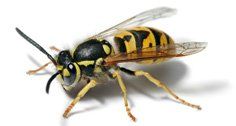
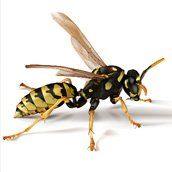
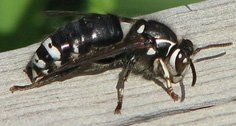
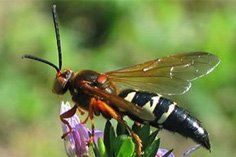
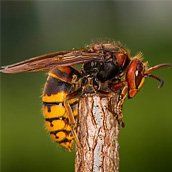
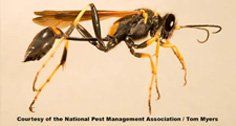

Share On: